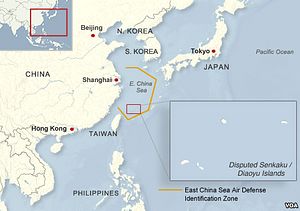China’s Air Defense Identification Zone announcement on November 23 drew immediate responses and strong criticism from all over the world. While a large amount of media reports and analysis articles have been produced since then, there are still several puzzling questions that have been overlooked or insufficiently addressed, especially regarding Beijing’s decision-making process. Among the questions: Was Beijing’s decision based on thorough research and careful planning? Was the policy research and planning leading to the ADIZ conducted chiefly by the PLA and or did other foreign policy institutes participate in this process? More importantly, did the top leadership have all of the details and accurate information, especially about the main differences between the Chinese version and the ADIZs of other countries, prior to the announcement? While many commentators on this issue generally have assumed that Beijing’s decision was based on the regime’s best calculations and reflected unified internal consensus, we don’t know whether it’s possible that this ADIZ decision was actually a policymaking failure.
The central distinction between China’s ADIZ and that of other countries, like the United States, is that China requires all planes that enter the ADIZ to notify China in advance, even if they do not plan to land at a Chinese airport. The ADIZs of the United States, for example, only require advanced notification of those planes planning to land. The US, through Defense Secretary Chuck Hagel’s statement, has made it clear that China’s demand for all planes to submit notification is an unacceptable requirement. A question to consider is whether China’s policy researchers were aware of this difference and reported it clearly and accurately to the top leadership. In another words, did Xi Jinping knew this difference clearly before the final announcement? Is it possible that his advisors only reported to him something like “each of our neighboring states has established their own ADIZ and there is nothing wrong with creating one by ourselves”?
I believe that such scenarios signal serious problems. If this were a thoughtful decision, then it unfortunately indicates that the government is making major adjustments to its foreign policy. However, this aggressive behavior contradicts the recent diplomatic efforts of both Xi Jinping and Li Keqiang during their trips to Southeast Asia. At the Diplomatic Work Conference on Periphery Diplomacy in late October, it was decided that China would improve its relations with its neighbors and abide by a friendlier foreign policy. One outcome from the Third Plenum in early November was the setup of ambitious economic reform. An aggressive policy that sparks strong responses and increases the possibility of conflict is obviously inconsistent with this principle. It is also possible that Beijing has decided to adopt a more assertive stance only towards Japan and the Philippines while being friendly to other countries. However, a conflict with either Japan or the Philippines is still harmful to the comprehensive reform plan, making this controversy quite puzzling.
The scenario of poor policymaking is also worrisome because it suggests that the decision was based on low-quality research and insufficient communication between advisors and decision makers. Questions on this scenario include: was the policy research and planning conducted solely by the PLA; did the Ministry of Foreign Affairs and think tanks participate in the decision making process; and did the policy making team evaluate possible responses and submit accurate and detailed reports to the top leadership before the announcement? A disconnect between the advisors and top leaders is especially troublesome when there is a risk of major conflict or incident.
China’s ADIZ announcement has undoubtedly caused considerable damage to China’s soft power. It will be used as an example of China’s status as a revisionist state and will further strengthen the China threat narrative. Therefore, it is difficult to understand why Beijing wanted to take this largely unnecessary aggressive step with the tremendous cost to its soft power and international image. If this was not Beijing’s goal or the responses from the outside were totally beyond Beijing’s expectation, then the ADIZ decision unfortunately indicates a decision-making failure.
In Chinese, the word “crisis” means both danger and opportunity. It could be an opportunity for Beijing to learn from this incident under both scenarios mentioned before. If it was mainly a policymaking mistake, China could use it to reflect and to reform its policymaking procedures as well as the collaboration between the different governmental units. If this was indeed a major policy shift, then after testing the water Beijing should know better about the temperature. However, there is also a danger that the harsh responses from China’s neighbors, especially Japan, could make Beijing go on the offensive to counter losing face. Diplomacy is an interactive process, meaning that these responses from other countries influence China’s future policy and behavior. In this sense, the way to deal with China’s possible policy mistake could also be a test for other countries.
China’s ADIZ announcement has made the security situation in East Asia more fragile. It is indeed a critical moment for all parties concerned to act carefully. It has become especially important to determine how the involved parties could avoid misinterpretation and misjudgment over each other’s strategic intentions.
































